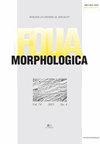Morphological study of superficial palmar arch and the significance in clinical operation.
IF 1.2
4区 医学
Q3 ANATOMY & MORPHOLOGY
引用次数: 0
Abstract
BACKGROUND The superficial palmar arch is a crucial blood supply to the palm. However, it exhibits significant variations, posing challenges in surgical procedures. Gaining a comprehensive understanding of the relationship between different types, physiological indices, and the clinical significance of the superficial palmar arch will enhance the accuracy of diagnosing and treating patients. MATERIALS AND METHODS In this study, we dissected a total of 72 specimens, comprising 39 males and 33 females. We observed the type, length, and diameter of the superficial palmar arch and analyzed its correlation with the disease. Additionally, we conducted Doppler ultrasound measurements on 20 healthy volunteers (10 males and 10 females) and 18 patients with superficial palmar arch injury (10 males and 8 females) to assess the classification, diameter, intimal thickness, and blood flow velocity of the superficial palmar arch. We collected information on 9 male patients with finger fracture and observed the classification of the superficial palmar arch, fracture healing time, and basic function recovery time. Lastly, we analyzed rare variant specimens encountered during the anatomy process. RESULTS In the exploration of human anatomy, there were four types of superficial palmar arch: ulnar artery arch type in 17 cases (23.61%), radial ulnar artery type in 46 cases (63.89%), ulnar artery without arch type in 6 cases (8.33%), and 3 cases (4.17%) of double arch type of radial and ulnar artery. One case non-arched type was found in imaging examination (5%). In one elderly male specimen, the hand's superficial palmar arch artery was tortuous and dilated. In addition, there was a positive correlation between the diameter and length of the superficial palmar arch (except the second common palmar digital artery in women), among which the ulnar artery and the third common palmar digital artery had the strongest correlation. Compared to healthy volunteers, patients with ulnar injury in the Radial-ulnar artery type exhibited a decrease in the diameter and blood flow velocity of the ulnar artery, as well as the second and third common palmar digital arteries. No such change was observed in patients with radial injury. Additionally, patients with ulnar injury in other types of Radial-ulnar artery also experienced a decrease in the diameter and blood flow velocity of the ulnar artery. Finger fracture patients with Ulnar artery with arch and Ulnar artery without arch had shorter fracture healing time and basic function recovery time compared to those with Radial-ulnar artery type. CONCLUSIONS This study investigated the relationship between the classification, physiological index, and clinical significance of the superficial palmar arch at all levels. The results demonstrated that when the superficial palmar arch is damaged, it is important to consider both the classification and the site of damage, as this can potentially result in improved therapeutic outcomes. These findings provide a basis for future clinical research.掌浅弓的形态学研究及其在临床操作中的意义。
背景掌弓浅层是手掌的重要血供来源。然而,它表现出明显的差异,给外科手术带来了挑战。全面了解掌浅弓的不同类型、生理指标和临床意义之间的关系将提高诊断和治疗患者的准确性。我们观察了掌浅弓的类型、长度和直径,并分析了其与疾病的相关性。此外,我们还对 20 名健康志愿者(10 名男性和 10 名女性)和 18 名掌浅弓损伤患者(10 名男性和 8 名女性)进行了多普勒超声测量,以评估掌浅弓的分类、直径、内膜厚度和血流速度。我们收集了 9 名男性手指骨折患者的信息,观察了掌浅弓的分类、骨折愈合时间和基本功能恢复时间。结果 在人体解剖学的探索中,掌浅弓有四种类型:尺动脉弓型 17 例(23.61%),桡尺动脉型 46 例(63.89%),尺动脉无弓型 6 例(8.33%),桡尺动脉双弓型 3 例(4.17%)。造影检查中发现 1 例为无弓型(5%)。在一例老年男性标本中,手掌浅弓动脉迂曲扩张。此外,掌弓浅动脉的直径与长度呈正相关(女性的第二掌骨总动脉除外),其中尺动脉和第三掌骨总动脉的相关性最强。与健康志愿者相比,桡-尺动脉型尺动脉损伤患者的尺动脉以及第二和第三掌侧数字总动脉的直径和血流速度均有所下降。而桡动脉损伤的患者则没有这种变化。此外,其他类型的桡-尺动脉损伤患者的尺动脉直径和血流速度也有所下降。与桡尺动脉类型的手指骨折患者相比,尺动脉有弓和尺动脉无弓的手指骨折患者的骨折愈合时间和基本功能恢复时间更短。结果表明,当掌浅弓受损时,必须同时考虑分类和受损部位,因为这有可能改善治疗效果。这些发现为今后的临床研究提供了依据。
本文章由计算机程序翻译,如有差异,请以英文原文为准。
求助全文
约1分钟内获得全文
求助全文
来源期刊

Folia morphologica
ANATOMY & MORPHOLOGY-
CiteScore
2.40
自引率
0.00%
发文量
218
审稿时长
6-12 weeks
期刊介绍:
"Folia Morphologica" is an official journal of the Polish Anatomical Society (a Constituent Member of European Federation for Experimental Morphology - EFEM). It contains original articles and reviews on morphology in the broadest sense (descriptive, experimental, and methodological). Papers dealing with practical application of morphological research to clinical problems may also be considered. Full-length papers as well as short research notes can be submitted. Descriptive papers dealing with non-mammals, cannot be accepted for publication with some exception.
 求助内容:
求助内容: 应助结果提醒方式:
应助结果提醒方式:


